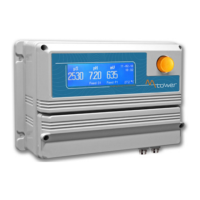7
Cooling tower basic knowledge.
If cooled water is returned from the cooling tower to be reused, some water must be added to replace, or make-up, the
portion of the ow that evaporates. Because evaporation consists of pure water, the concentration of dissolved minerals
and other solids in circulating water will tend to increase unless some means of dissolved-solids control, such as blow-
down, is provided. Some water is also lost by droplets being carried out with the exhaust air (drift), but this is typically
reduced to a very small amount by installing bafe-like devices, called drift eliminators, to collect the droplets. The make-
up amount must equal the total of the evaporation, blow-down, drift, and other water losses such as wind blowout and
leakage, to maintain a steady water level.
Some useful terms, commonly used in the cooling tower industry:
Drift - Water droplets that are carried out of the cooling tower with the exhaust air. Drift droplets have the same concen-
tration of impurities as the water entering the tower. The drift rate is typically reduced by employing bafe-like devices,
called drift eliminators, through which the air must travel after leaving the ll and spray zones of the tower.
Blow-out - Water droplets blown out of the cooling tower by wind, generally at the air inlet openings. Water may also
be lost, in the absence of wind, through splashing or misting. Devices such as wind screens, louvers, splash deectors
and water diverters are used to limit these losses.
Plume - The stream of saturated exhaust air leaving the cooling tower. The plume is visible when water vapor it
contains condenses in contact with cooler ambient air, like the saturated air in one’s breath fogs on a cold day. Under
certain conditions, a cooling tower plume may present fogging or icing hazards to its surroundings. Note that the water
evaporated in the cooling process is “pure” water, in contrast to the very small percentage of drift droplets or water blown
out of the air inlets.
Blow-down - The portion of the circulating water ow that is removed in order to maintain the amount of dissolved
solids and other impurities at an acceptable level.
Leaching - The loss of wood preservative chemicals by the washing action of the water owing through a wood struc-
ture cooling tower.
Noise - Sound energy emitted by a cooling tower and heard (recorded) at a given distance and direction. The sound is
generated by the impact of falling water, by the movement of air by fans, the fan blades moving in the structure, and the
motors, gearboxes or drive belts.

